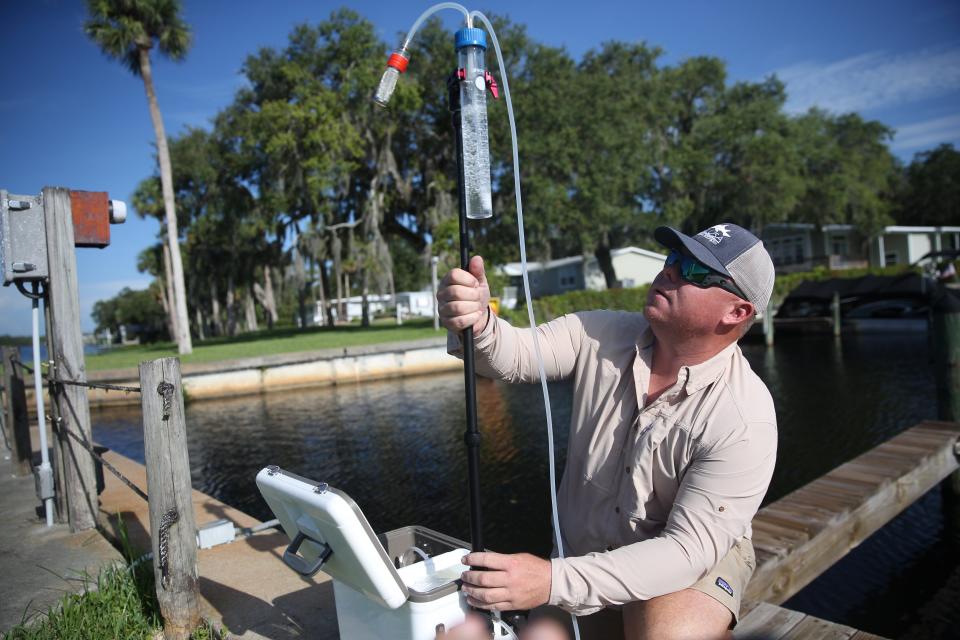DOH issues blue-green algae advisory for Caloosahatchee River. Where else are blooms?
A blue-green algae outbreak in the Caloosahatchee River appears to be spreading as the state issued more contact advisories Friday.
The Florida Department of Health in Lee County issued an advisory for the Alva Boat Ramp after April 8 samples taken there showed toxins in the water.
Where else is algae a problem?
"Lee is also cautioning the public of the presence of blue-green algae blooms in the Caloosahatchee River (at the) Palace Grande Canal, Caloosahatchee River (at) Walpole Canal, and Whiskey Creek (at the) Winkler Road Canal," a DOH press release reads. "Blooms have the potential to produce toxins, and what triggers them to do so remains poorly understood. Since bloom conditions can change at any time, it is important to exercise caution as if the bloom were toxic, even if toxin presence has not yet been confirmed."

What to know about blue-green algae
Blue-green algae is naturally present at background levels in Florida waterways like Lake Okeechobee and the Caloosahatchee River, but concentrations can turn toxic during outbreaks.
Blue-green algae has also been reported in upstream areas of the river and in places like Cape Coral.
"Blue-green algae are a type of bacteria that is common in Florida’s freshwater environments," the DOH press release says. "A bloom occurs when rapid growth of algae leads to an accumulation of individual cells that discolor water and often produce floating mats that emit unpleasant odors. Some environmental factors that contribute to blue-green algae blooms are sunny days, warm water temperatures, still water conditions and excess nutrients."
Algae toxins can kill domestic animals, pets, fish and other wildlife. They can also cause problems in humans ranging from hay fever-like symptoms to gastrointestinal distress, according to the Florida Fish and Wildlife Conservation Commission.
More: Mote Marine, FWC rescue endangered sawfish 'whirling' in the Florida Keys
When do outbreaks normally occur?
These outbreaks typically occur during summer months as the algae prefers warmer conditions, but blooms can happen during any time of the year.
A 2018 blue-green algae bloom crippled the Fort Myers-Cape Coral area as thick mats of algae blanketed canals across the region for months.
That bloom started on Lake Okeechobee early in the summer and spread to the Southwest Florida coast, and a state of emergency was declared for Lee County.
Army Corps starts Lake O releases to Fort Myers
The U.S. Army Corps of Engineers increased releases Saturday to the Caloosahatchee River, pushing 2,000 cubic feet per second of water through the W.P. Franklin Lock and Dam, the structures that separates the downstream estuary from the upstream freshwater portion of the river.
Healthy flows for the river and its estuary range from around 400 cubic feet per second to 2,800 cubic feet per second. Anything outside of that envelop can be harmful for oysters and sea grass, indicators used to measure the health of the estuary.
More: Feds designate 13 Florida counties as critical habitat for nation's most endangered bat
Florida Department of Environmental Protection records show that a bloom persists on the west side of Lake Okeechobee, but Florida Gulf Coast University professor and blue-green algae expert Mike Parsons said the lake was not inoculating the river as blue-green algae has been documented in the Caloosahatchee River for several weeks.
Lake Okeechobee releases to the Caloosahatchee could be a regular occurrence for the next several weeks as the U.S. Army Corps of Engineers tries to lower the lake before the coming rainy and hurricane seasons.
Some health and safety tips
The Florida Department of Health offers these tips to reduce your risk and risk to pets:
Avoid scummy, foamy water where algae mats are present (Heavy blooms often appear as bright or pea green to reddish-brown water, occasionally with a "paint scum" appearance due to dead algae, and may emit unpleasant gassy odors.)
Don't cook with, eat fish from, or drink scummy water
Do not let your pets or children eat or drink from affected waters
Don't eat fish that look unhealthy
Do not harvest dead or dying fish or shellfish
Do not swim in, jet ski over, or play near scummy water or algal mats
Do not allow your pets or children to swim in, drink from, or play near scummy water
Do not irrigate with scummy water
Do not use herbicides to kill blooms (this can release the toxins directly into the water)
Minimize nutrient runoff and use of fertilizers (this reduces the risk of a potential harmful bloom occurring)
If contact with suspect or contaminated water occurs, wash off immediately and thoroughly with clean water and soap (make sure to rinse the swimsuit areas and your pets' fur). Consult a doctor if illness occurs. Contact a veterinarian if your pet suddenly becomes lethargic or shows signs of poisoning including vomiting, diarrhea, or seizures.
Connect with this reporter: Chad Gillis on Facebook.
This article originally appeared on Fort Myers News-Press: Algae update: Bloom conditions linger as Lake O releases continue

